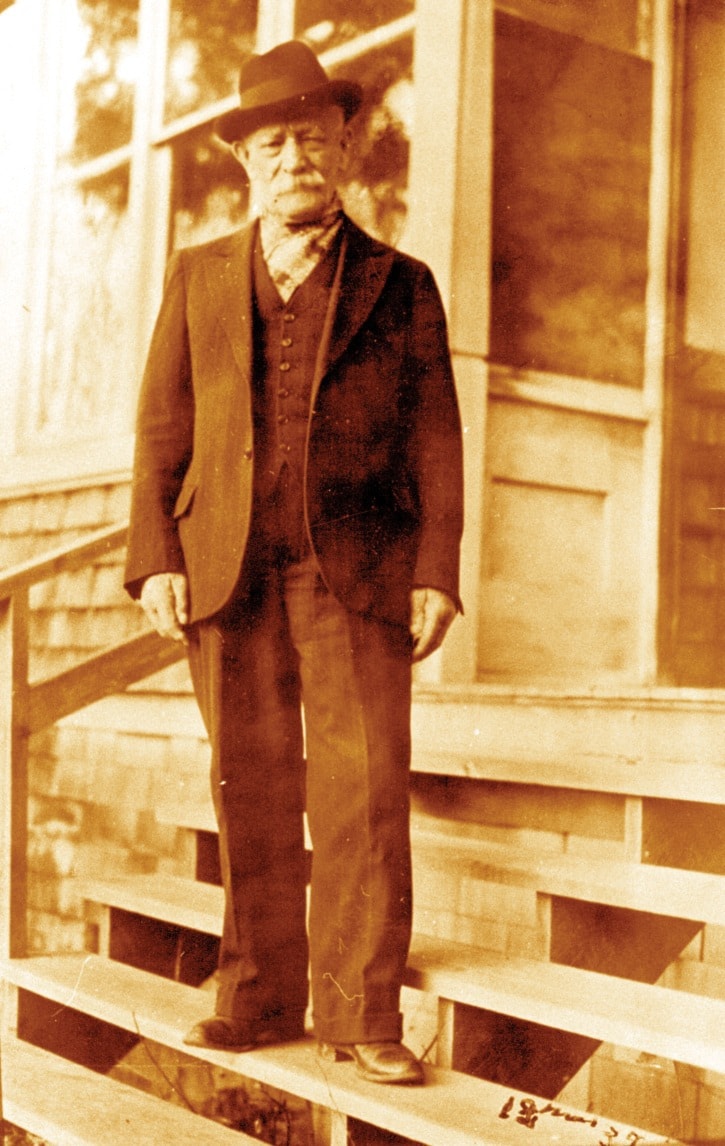A quip that White Rock was fast becoming the ‘thrift shop capital of Canada’ brought to mind a different thought we had on arriving in White Rock.
With Thrift Avenue and Thrift School, we wondered if we had landed in an exceptionally frugally-minded community.
At that time, it wasn’t easy to discover the reason for the naming – no signage, and the White Rock archives hadn’t yet been established.
For those equally curious, here’s the lowdown.
An enterprising man named Henry Thrift was the source of it all. By the time he died in 1946, he’d had a finger in most Surrey and White Rock pies.
Anyone more energetic would be hard to imagine. An often-told story typifies his life. One day, as he was hustling along a road, Thrift was overtaken by a man driving a horse and wagon. The man offered him a ride to which Thrift replied, “No thanks, I’m in a hurry.”
A brickmaker by trade, Henry Thomas Thrift was born in England in 1851. He served in the Hampshire Infantry, married, and had three children. After his wife died, he emigrated to eastern Canada, married Margaret McMenamy in Ontario in 1877, and started a second family which ultimately included three sons and six daughters.
He soon became restless to see the rest of the continent, travelled to California and, finally, when confronted with an emigration problem, to B.C. His notes say he happened to see Surrey for the first time in the fall of 1880 while going to Victoria to meet his wife on her arrival from the east.
“With the Fraser frozen over and no boats running, I started out in a snowstorm and walked to New Westminster from Yale. On the way, I looked over the lands of Langley and Surrey with the view of getting located later.”
True to his word, he settled first in Clover Valley (now Cloverdale) partly because “the name Surrey sounded like home.”
He was instrumental in starting Surrey’s first school in 1882, and succeeded John Oliver (later B.C. premier) as municipal clerk in 1883. Except for two years, he held this position until 1891, when he was elected reeve of Surrey. He resigned after a few months due to a dyking controversy.
Meanwhile, in 1884, he had taken up land in Hall’s Prairie, naming his farm Hazelmere. He started a weekly mail route from New Westminster to several points along the way to Hall’s Prairie, and established a post office in his home.
In 1886, in his capacity as clerk, Thrift was instructed to write to the minister of the interior to request that, “12 acres of public lands at the boundary line be granted for a public or international park, and that said land be vested in the council for the benefit of the public.”
This was the beginning of Peace Arch Park.
A smallpox epidemic ravaging Langley prompted Surrey Council to appoint Thrift health officer in 1888, with the specific duty to see that all adults resident in Surrey were inoculated.
At the same time, he managed to carry on a real estate business, advertising lots for sale in Blaine, B.C., now known as the Douglas area. With other Surrey businessmen, he tried to purchase parcels of the attractive lands of the Semiahmoo Reserve in the late 1880s.
To aid new settlers, Thrift established the Settlers Association, which petitioned federal and provincial governments, in 1903, to build a bridge across the Fraser River.
In 1906, as secretary-treasurer of the International Railway and Development Company, he did not object to the construction of the railway along the waterfront, but considered public access to the beach to be an essential part of the deal. While GN crews were laying the track from the border to White Rock, Thrift travelled to Victoria in an effort to protect the seafront road for the community, but was unsuccessful.
All this before he ‘retired’ to White Rock in 1910 to build his family home on property on Buena Vista Avenue he had purchased in anticipation of the arrival of the railway.
He was soon in the thick of things, organizing a Boy Scout troop, the first in Surrey, and conducting Sunday school classes on his lawn. He acted as MC for the annual May Day celebrations. White Rock’s first school was built on his property.
Civic and social matters were not neglected, either. He was a leading light in persuading the federal minister of fisheries that White Rock needed a pier, was a founding father of White Rock Water Works, and ceremoniously ‘pulled the switch’ to give White Rock electric lights.
As early as 1912, Thrift was serving as vice-president of the local ratepayers association, an organization through which he continually urged the improvement of the seafront road. Like others, when Surrey municipal government ignored his pleas, he advocated direct representation (a separate ward) or incorporation for White Rock.
He continued his abiding interest in the welfare of White Rock, hale and hardy into his 90s. The year after his death, a Juvenile Orange Lodge was formed in White Rock, choosing the name ‘Thrift’ in memory of H.T. Thrift who had at one time been grand master of the B.C. Orange Lodge.
Just one more honour for one of our illustrious pioneers.
The Peninsula’s best-known mother-and-son historians, Lorraine and Hugh Ellenwood, are dedicated to preserving history through the White Rock Museum & Archives. Call 604-541-2222, or email whiterockarchives@telus.net
